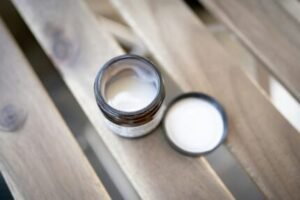Medically reviewed by Dr. Ramesh Gaddam, M.D. — Written by Sumalatha, D.N.H.E
Table of Contents
TogglePersistent dry skin, despite regular moisturizing, can result from numerous factors. Common culprits include environmental conditions, harsh cleansing products, over-washing, underlying skin conditions, medications, inadequate hydration, dietary deficiencies, aging, and excessive exfoliation. Understanding these causes is crucial for effectively addressing and managing dry skin concerns.
Potential Factors
Several factors could contribute to your face still feeling dry even after moisturizing:

Insufficient Moisture:
selecting the right moisturizer is crucial for effectively addressing dry skin.
Here’s how to ensure you’re using a moisturizer that provides sufficient hydration:
Choose a Richer Formula:
If you have dry skin, opt for moisturizers with heavier textures, such as creams or ointments, rather than lotions.
These formulations typically contain more emollient ingredients that can help lock in moisture and provide longer-lasting hydration.
Look for Hydrating Ingredients:
Ingredients are known for their hydrating properties includes:
- Hyaluronic acid
- Glycerin
- Shea butter and
- Ceramides
Seek out moisturizers that contain these ingredients to help replenish moisture and improve skin hydration levels.
Recommended Moisturizers for Dry Skin : Buy Best Moisturizers
Consider Layering Products:
In addition to your moisturizer, consider incorporating a hydrating serum or facial oil into your skincare routine.
These products can provide an extra boost of hydration when applied underneath your moisturizer, helping to address dryness more effectively.
Apply Moisturizer Correctly:
Make sure to apply your moisturizer to clean, damp skin to help seal in moisture. Gently massage the moisturizer into your skin using upward motions until it’s fully absorbed.
Don’t forget to include your neck and décolletage in your skincare routine, as these areas can also experience dryness.
Reapply Throughout the Day:
If your skin feels dry or tight throughout the day, consider reapplying moisturizer as needed to help maintain hydration levels.
Carry a travel-sized moisturizer with you for convenient touch-ups, especially in dry or air-conditioned environments.
Summary:
By choosing a moisturizer specifically formulated for dry skin and incorporating hydrating ingredients into your skincare routine, you can help alleviate dryness and improve the overall health and hydration of your skin.
If you’re unsure which moisturizer is best suited for your skin type, consider consulting a dermatologist for personalized recommendations.
Overuse of Harsh Products
overuse of harsh skincare products can indeed exacerbate dryness and irritation.

Here’s how to identify and address the issue:
Review Your Skincare Products:
Take a close look at the ingredients list of your skincare products, including cleansers, toners, exfoliants, and treatments.
Look out for common drying ingredients such as:
Alcohol (denatured alcohol, SD alcohol), Fragrances, sulfates, and high concentrations of exfoliating acids like salicylic acid or glycolic acid.
Avoid Harsh Ingredients:
Opt for gentle, hydrating skincare products formulated for dry or sensitive skin.
Look for products labeled as “alcohol-free,” “fragrance-free,” and “sulfate-free.”
Consider switching to milder cleansers, gentle exfoliants (such as those containing lactic acid or PHA), and soothing, hydrating toners.
Limit Exfoliation:
Exfoliating too frequently or using overly abrasive exfoliants can compromise the skin’s barrier function and lead to increased dryness and sensitivity.
Reduce the frequency of exfoliation to once or twice a week, and choose gentle exfoliants that won’t strip the skin of its natural oils.
Patch Test New Products:
Before introducing a new skincare product into your routine, perform a patch test to assess how your skin reacts.
Apply a small amount of the product to a discreet area of your skin (such as the inner forearm) and observe for any signs of irritation or allergic reaction over the next 24-48 hours.
Listen to Your Skin:
Pay attention to how your skin responds to different products and adjust your skincare routine accordingly.
If you notice increased dryness, redness, or irritation after using a particular product, discontinue use and seek out gentler alternatives.
Consult a Dermatologist:
If you’re unsure which products are suitable for your skin type or if you’re experiencing persistent dryness despite making changes to your skincare routine, consider consulting a dermatologist.
A dermatologist can assess your skin’s specific needs and recommend tailored skincare products and treatments to address your concerns.
By avoiding harsh skincare products and choosing gentle, hydrating alternatives, you can help alleviate dryness and maintain a healthy, balanced complexion.
Environmental Factors
Environmental factors play a significant role in skin hydration and health.

Here’s how you can protect your skin from harsh environmental conditions:
Indoor Humidity:
Dry indoor air, especially during colder months when heaters are running, can deplete the skin’s moisture levels.
Using a humidifier in your home or office can help add moisture to the air, preventing excessive dryness and maintaining skin hydration.
Protective Clothing:
When venturing outdoors in cold or windy weather, wearing protective clothing such as scarves, hats, and gloves can help shield your skin from harsh environmental elements.
Opt for soft, breathable fabrics like cotton or silk to minimize irritation.
Sun Protection:
UV radiation from the sun can also contribute to dryness and skin damage.
Apply a broad-spectrum sunscreen with an SPF of 30 or higher to exposed skin, including your face, neck, and hands, even on cloudy days.
Reapply sunscreen every two hours, or more frequently if you’re sweating or swimming.
Moisturize Regularly:
Regardless of the season, maintaining a consistent moisturizing routine is essential for keeping your skin hydrated and protected.
Choose a moisturizer that suits your skin type and contains hydrating ingredients like hyaluronic acid, glycerin, or ceramides.
Apply moisturizer immediately after bathing or showering to lock in moisture.
Avoid Hot Water:
While it may be tempting to take hot showers or baths, especially in cold weather, hot water can strip the skin of its natural oils and exacerbate dryness.
Opt for lukewarm water instead, and limit shower or bath time to no more than 10-15 minutes.
Stay Hydrated:
Drinking an adequate amount of water is essential for overall skin health and hydration.
Aim to drink at least eight glasses of water per day to help keep your skin hydrated from the inside out.
By taking proactive steps to protect your skin from environmental stressors and maintaining a consistent skincare routine, you can help prevent dryness and maintain a healthy, glowing complexion year-round.
Underlying Skin Conditions
Underlying skin conditions can significantly contribute to chronic dryness and require specialized treatment. Here’s how to identify and address potential skin conditions:
Recognize Symptoms:
Skin conditions like eczema (atopic dermatitis), psoriasis, and rosacea often present with symptoms beyond dryness, such as redness, inflammation, itching, and flakiness.

Pay attention to any persistent or worsening skin symptoms, and note any triggers that may exacerbate your condition.
Consult a Dermatologist:
If you suspect you have a skin condition contributing to your dry skin, it’s essential to consult a dermatologist for a proper diagnosis and treatment plan.
Dermatologists are trained to identify various skin conditions and can recommend appropriate therapies based on your specific needs.
Treatment Options:
Treatment for underlying skin conditions typically involves a combination of skincare interventions, topical medications, oral medications, and lifestyle modifications. For example:
Eczema:
Treatment may include moisturizers, topical corticosteroids, calcineurin inhibitors, and lifestyle changes to minimize triggers.
Psoriasis:
Treatment may involve topical corticosteroids, vitamin D analogs, retinoids, biologic therapies, phototherapy, and systemic medications.
Rosacea:
Treatment may include gentle skincare, topical medications (e.g., metronidazole, azelaic acid), oral antibiotics, and laser therapy.
Follow Treatment Plan
Once you’ve been diagnosed with a skin condition, it’s essential to follow your dermatologist’s treatment plan consistently.
This may involve using prescribed medications as directed, adhering to a skincare regimen tailored to your condition, and making necessary lifestyle adjustments to manage triggers.
Manage Triggers:
Identifying and managing triggers that exacerbate your skin condition can help minimize flare-ups and improve symptoms.
Common triggers for skin conditions include stress, certain foods, environmental factors (e.g., temperature extremes, sun exposure), and skincare products containing irritants.
Monitor and Adjust:
Regularly monitor your skin’s response to treatment and communicate any concerns or changes to your dermatologist.
Depending on your condition, treatment may need to be adjusted or modified over time to ensure optimal management of symptoms.
By seeking professional evaluation and treatment for underlying skin conditions, you can effectively address chronic dryness and improve the overall health and comfort of your skin.
Dehydration
Hydration is essential for maintaining healthy skin from the inside out.

Here’s how staying hydrated can help improve skin hydration:
Water Content:
The skin contains a significant amount of water, which contributes to its elasticity, suppleness, and overall appearance.
Drinking enough water helps ensure that skin cells are adequately hydrated, promoting a plump and radiant complexion.
Moisture Balance:
Proper hydration helps regulate the skin’s moisture balance, preventing issues like excessive dryness or oiliness.
When the body is dehydrated, it can lead to dry, flaky skin, which can exacerbate problems like itching, irritation, and inflammation.
Toxin Elimination:
Water plays a vital role in flushing toxins and impurities from the body, which can contribute to clearer, healthier-looking skin.
Adequate hydration supports the body’s natural detoxification processes, promoting a more radiant and youthful complexion.
Skin Barrier Function:
Maintaining adequate hydration is crucial for preserving the skin’s barrier function.
The skin’s barrier acts as a protective shield against environmental stressors, pollutants, and pathogens.
A strong skin barrier helps lock in moisture, prevent moisture loss, and protect against damage from external factors.
Preventing Premature Aging
Dehydrated skin is more prone to developing fine lines, wrinkles, and sagging, which can contribute to the appearance of premature aging.
By staying hydrated, you can help preserve the skin’s elasticity and firmness, reducing the risk of premature aging and promoting a more youthful complexion.
Staying Hydrated
Drink water throughout the day, aiming for at least eight 8-ounce glasses (about 2 liters) per day, or more depending on factors like activity level, climate, and overall health.
Incorporate hydrating foods into your diet, such as fruits and vegetables with high water content, like:
- Cucumbers,
- Watermelon,
- Strawberries, and
- Oranges.
Limit or avoid excessive consumption of dehydrating beverages like alcohol and caffeinated drinks, which can contribute to dehydration.
Summary:
Listen to your body’s thirst signals and drink water whenever you feel thirsty, as thirst is a sign that your body needs hydration.
By prioritizing hydration both internally and externally, you can help maintain optimal skin health and achieve a hydrated, glowing complexion.
Incorrect Application
The way you apply moisturizer can significantly impact its effectiveness in hydrating your skin.

Here’s a closer look at the correct application technique:
Cleanse Your Skin:
Start by cleansing your skin with a gentle cleanser suited to your skin type.
Cleansing helps remove dirt, oil, and impurities from the skin, allowing the moisturizer to penetrate more effectively.
Pat Your Skin Dry:
After cleansing, gently pat your skin dry with a soft towel.
Avoid rubbing or scrubbing your skin, as this can cause irritation and disrupt the skin’s moisture barrier.
Apply Moisturizer While Skin is Damp:
For optimal hydration, apply moisturizer while your skin is still slightly damp from cleansing.
Damp skin allows the moisturizer to trap moisture and create a barrier that helps prevent water loss throughout the day.
Use the Right Amount:
Dispense an appropriate amount of moisturizer onto your fingertips.
You don’t need to use a large amount; a pea-sized or dime-sized amount is typically sufficient for the face.
If you’re applying moisturizer to other areas of the body, adjust the amount accordingly.
Gently Massage into Skin:
Using gentle, upward motions, massage the moisturizer into your skin until it’s fully absorbed.
Pay attention to areas prone to dryness, such as the cheeks, forehead, and around the eyes.
Include Neck and Décolletage:
Don’t forget to extend the application of moisturizer to your neck and décolletage.
These areas are often overlooked but can also benefit from hydration and nourishment.
Allow Time to Absorb:
Give the moisturizer a few minutes to fully absorb into your skin before applying any additional skincare products or makeup. This allows the moisturizer to work its magic and create a smooth, hydrated base for makeup application if desired.
By following these steps and applying moisturizer correctly, you can maximize its hydrating benefits and keep your skin looking and feeling its best.
Additionally, consistency is key, so make moisturizing a part of your daily skincare routine to maintain optimal hydration levels.
Medically reviewed by Dr. Ramesh Gaddam, M.D.

General Physician, Diabetologist, and Critical Care Specialist.
Related
Discover more from Health Build-Up
Subscribe to get the latest posts sent to your email.
Pingback: How to Remove Skin Tags in One Night with Toothpaste : Tips
Pingback: Does Rubbing Salt on Skin Make It Tougher : Salt & Skin Care
Pingback: Thyroid Disorders: Causes, Symptoms, Treatment (9 Diet Tips)
Pingback: How to Get Nail Glue Off Skin: Super Tips